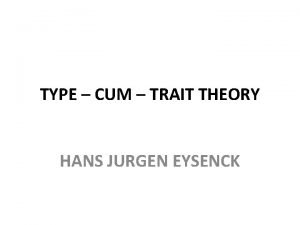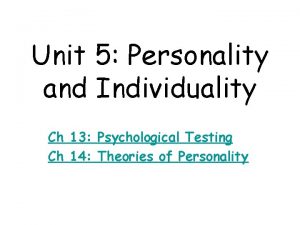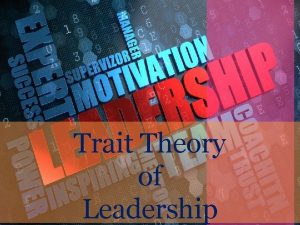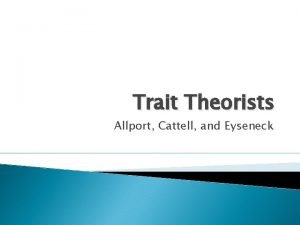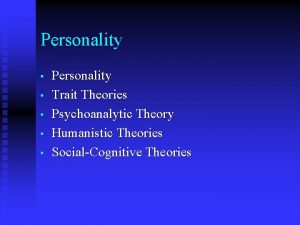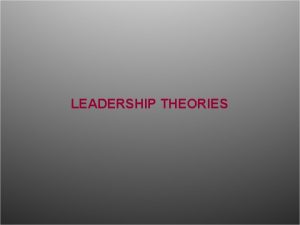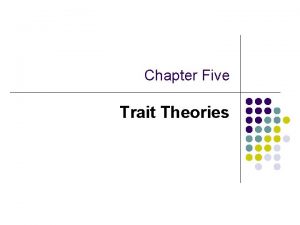THEORIES OF PERSONALITY Theories of Personality Type Trait








- Slides: 8

THEORIES OF PERSONALITY

Theories of Personality Type Trait Psychoanalytic Theories of Personality Humanistic Behavioural

Theories of personality Humanistic Approach Carl Roger’s Self Theory Abraham Maslow’s Need Hierarchy • The Humanistic theories are mainly developed in response to Freud’s theory. • Carl Rogers and Abraham Maslow - particularly contributed to the development of humanistic perspective on personality • focus on the things that make people uniquely human • Humanistic Theories focus on the positive aspect of human personality.

IV. HUMANISTIC APPROACH (1)CARL ROGER’S theory of Self • Carl Rogers(1961) believed that human beings are always striving to fulfil their innate capacities and capabilities and to become everything that their genetic potential will allow them to become. • Fully functioning person • Rogers makes two basic assumptions about human behaviour: (a)Behaviour is goal-directed and worthwhile. (b)People (who are innately good) will almost always choose adaptive, self-actualising behaviour.

IV. HUMANISTIC APPROACH (1)CARL ROGER’S theory of Self (2) • structured around the concept of self. • The theory assumes that people are constantly engaged in the process of actualising their true self. • Self –Actualisation • Ideal self • Real Self • Discrepancy between the real self and ideal self often results in unhappiness and dissatisfaction. • Rogers’ basic principle is that people have a tendency to maximise self-concept through self -actualisation. In this process, the self grows, expands and becomes more social.

REFLECTION SPOT… Reflect upon your ideal and real self. .

IV. HUMANISTIC APPROACH (2)Maslow’s need hierarchy Ø The theory is also known as theory of Self Actualisation. Ø conceptualised as a pyramid in which the bottom of this hierarchy represents the basic to survival such as, hunger, thirst, etc. Ø Safety needs of physical and physiological nature. Ø Need for belongingness Ø Esteem needs, i. e. The need to develop a sense of self worth. Ø Self Actualisation

REFLECTION SPOT… At what level of hierarchy are you?
 Trait theory hans eysenck
Trait theory hans eysenck Trait theories of personality _____.
Trait theories of personality _____. Traits theory of leadership
Traits theory of leadership Trait theory of personality
Trait theory of personality Humanistic theories emphasize
Humanistic theories emphasize Social cognitive personality
Social cognitive personality Summarize the conclusions of trait theories of leadership
Summarize the conclusions of trait theories of leadership Summarize the conclusions of trait theories of leadership.
Summarize the conclusions of trait theories of leadership. Summarize the conclusions of trait theories of leadership.
Summarize the conclusions of trait theories of leadership.
